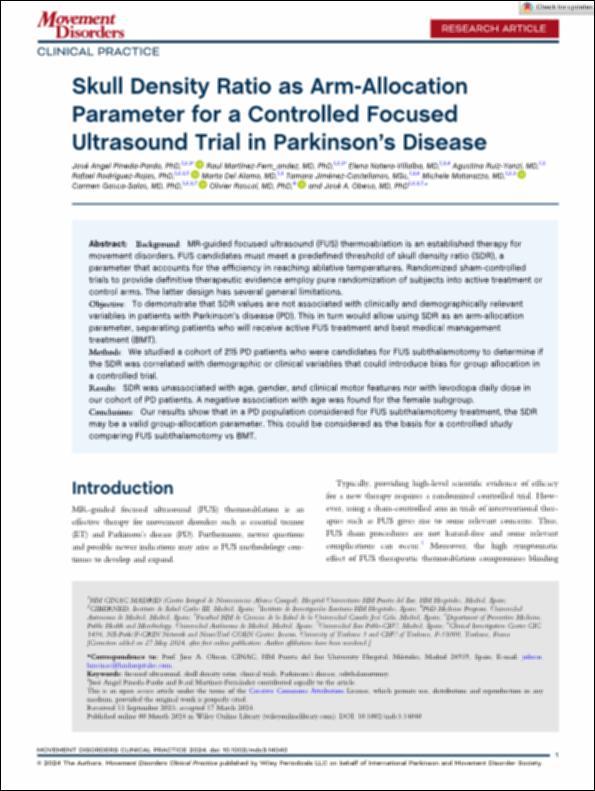Por favor, use este identificador para citar o enlazar este ítem:
http://hdl.handle.net/10637/15927Skull Density Ratio as Arm-Allocation Parameter for a Controlled Focused Ultrasound Trial in Parkinson’s Disease
| Título : | Skull Density Ratio as Arm-Allocation Parameter for a Controlled Focused Ultrasound Trial in Parkinson’s Disease |
| Autor : | Pineda-Pardo, José A. Martínez-Fernández, Raúl Natera Villalba, Elena Ruiz Yanzi, Agustina Rodríguez Rojas, Rafael Álamo, Marta del Jiménez Castellanos, Tamara Matarazzo, Michele Gasca Salas, Carmen Rasco, Olivier Obeso Inchausti, José Ángel |
| Materias: | Parkinson, Enfermedad de; Trastornos motores; Focused ultrasound |
| Editorial : | Wiley |
| Citación : | Pineda-Pardo, J.A., Martínez-Fern_andez, R., Natera-Villalba, E., Ruiz-Yanzi, A., Rodríguez-Rojas, R., Del Alamo, M., Jiménez-Castellanos, T., Matarazzo, M., Gasca-Salas, C., Rascol, O. and Obeso, J.A. (2024), Skull Density Ratio as Arm-Allocation Parameter for a Controlled Focused Ultrasound Trial in Parkinson's Disease. Mov Disord Clin Pract. https://doi.org/10.1002/mdc3.14040 |
| Resumen : | Background: Background MR-guided focused ultrasound (FUS) thermoablation is an established therapy for movement disorders. FUS candidates must meet a predefined threshold of skull density ratio (SDR), a parameter that accounts for the efficiency in reaching ablative temperatures. Randomized sham-controlled trials to provide definitive therapeutic evidence employ pure randomization of subjects into active treatment or control arms. The latter design has several general limitations. Objective: Objective To demonstrate that SDR values are not associated with clinically and demographically relevant variables in patients with Parkinson’s disease (PD). This in turn would allow using SDR as an arm-allocation parameter, separating patients who will receive active FUS treatment and best medical management treatment (BMT). Methods: Methods We studied a cohort of 215 PD patients who were candidates for FUS subthalamotomy to determine if the SDR was correlated with demographic or clinical variables that could introduce bias for group allocation in a controlled trial. Results: Results SDR was unassociated with age, gender, and clinical motor features nor with levodopa daily dose in our cohort of PD patients. A negative association with age was found for the female subgroup. Conclusions: Conclusions Our results show that in a PD population considered for FUS subthalamotomy treatment, the SDR may be a valid group-allocation parameter. This could be considered as the basis for a controlled study comparing FUS subthalamotomy vs BMT. |
| URI : | http://hdl.handle.net/10637/15927 |
| Derechos: | http://creativecommons.org/licenses/by-nc-nd/4.0/deed.es Open Access |
| ISSN : | 2330-1619 |
| Cubierto por: | Acuerdo Transformativo – 2024 |
| Fecha de publicación : | 13-may-2024 |
| Centro : | Universidad San Pablo-CEU |
| Aparece en las colecciones: | Medicina |
Los ítems de DSpace están protegidos por copyright, con todos los derechos reservados, a menos que se indique lo contrario.


